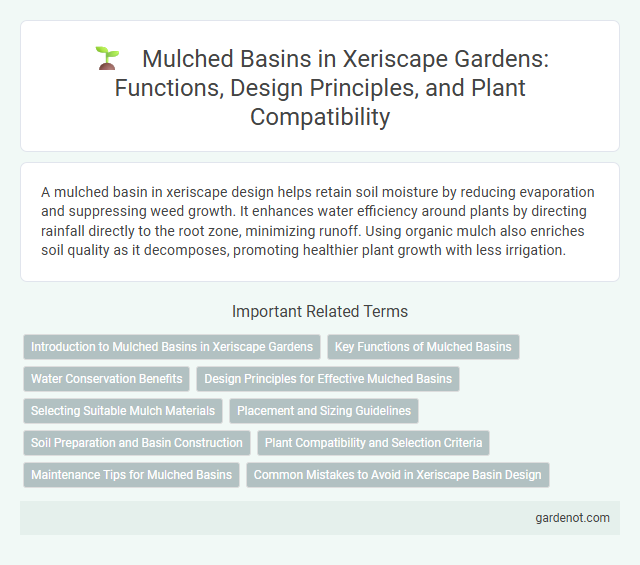A mulched basin in xeriscape design helps retain soil moisture by reducing evaporation and suppressing weed growth. It enhances water efficiency around plants by directing rainfall directly to the root zone, minimizing runoff. Using organic mulch also enriches soil quality as it decomposes, promoting healthier plant growth with less irrigation.
Introduction to Mulched Basins in Xeriscape Gardens
Mulched basins in xeriscape gardens enhance water retention by creating a shallow depression around plants, directing moisture precisely to the root zone and reducing evaporation. These basins are typically layered with organic mulch, such as wood chips or bark, which improves soil quality and promotes healthy plant growth while conserving water. Incorporating mulched basins in xeriscaping maximizes irrigation efficiency and supports drought-tolerant landscaping practices.
Key Functions of Mulched Basins
Mulched basins enhance water retention by reducing surface evaporation and promoting infiltration into the soil, crucial for xeriscape landscapes. They suppress weed growth and regulate soil temperature, which minimizes stress on drought-tolerant plants. These basins also improve nutrient availability by facilitating organic matter decomposition within the mulch layer.
Water Conservation Benefits
Mulched basins in xeriscaping significantly reduce water evaporation by maintaining consistent soil moisture, which conserves water resources. The mulch layer acts as a barrier against wind and sun, limiting moisture loss and promoting deep root growth. This practice enhances drought resistance and minimizes irrigation frequency, making it an effective water conservation strategy.
Design Principles for Effective Mulched Basins
Mulched basins optimize water conservation by incorporating permeable soil layers topped with organic mulch to reduce evaporation and enhance infiltration. Design principles emphasize proper basin sizing to capture runoff efficiently, selecting mulch materials that maintain moisture while preventing erosion, and contouring the basin to direct water flow uniformly. Incorporating native drought-tolerant plants within mulched basins further improves water retention and supports sustainable xeriscape landscaping.
Selecting Suitable Mulch Materials
Choosing appropriate mulch materials for a mulched basin in xeriscape landscaping enhances water retention and soil temperature regulation. Organic mulches such as bark chips, wood chips, and composted leaves improve soil fertility while inorganic options like gravel or crushed rock provide durability and reduce evaporation. Selecting mulch with high permeability and local availability ensures effective moisture conservation and supports sustainable xeriscape practices.
Placement and Sizing Guidelines
Mulched basins in xeriscape design should be placed around the root zones of plants to enhance water retention and reduce soil evaporation. The basin diameter typically ranges from 2 to 3 times the drip line of the plant to maximize moisture capture while preventing water runoff. Proper sizing ensures efficient irrigation, promoting healthy plant growth with minimal water waste.
Soil Preparation and Basin Construction
Soil preparation for mulched basins involves loosening compacted soil to improve aeration and water infiltration, ensuring healthy root growth for drought-tolerant plants. Basin construction requires shaping a shallow depression around the plant, typically 12 to 18 inches deep, to capture and retain water efficiently during irrigation or rainfall. Applying a 2-3 inch layer of organic mulch within the basin reduces evaporation, suppresses weeds, and enhances soil moisture retention in xeriscape landscapes.
Plant Compatibility and Selection Criteria
Mulched basins in xeriscaping enhance water retention and reduce evaporation, making them ideal for drought-tolerant plants like succulents, native grasses, and Mediterranean herbs. Selecting plants that thrive in well-drained, nutrient-modified soil within mulched basins ensures optimal growth and sustainability. Prioritize species with deep root systems and low water requirements to maximize the efficiency of mulched basins in arid landscapes.
Maintenance Tips for Mulched Basins
Maintaining mulched basins involves regular inspection to ensure mulch depth remains consistent at 2-3 inches, preventing weed growth and conserving soil moisture in xeriscape landscapes. Periodic replenishment of organic mulch like wood chips or bark supports soil health while minimizing evaporation in arid environments. Avoid piled mulch against plant stems to reduce rot risk and promote proper aeration within drought-tolerant planting basins.
Common Mistakes to Avoid in Xeriscape Basin Design
Mulched basins in xeriscape design often suffer from over-mulching, which can suffocate plant roots and inhibit water absorption. Incorrect basin sizing is another common mistake, as basins that are too small fail to capture sufficient runoff, reducing water efficiency. Using inappropriate mulch types, such as those that repel water or break down too quickly, disrupts soil moisture retention and undermines xeriscape sustainability goals.
Mulched basin Infographic

 gardenot.com
gardenot.com